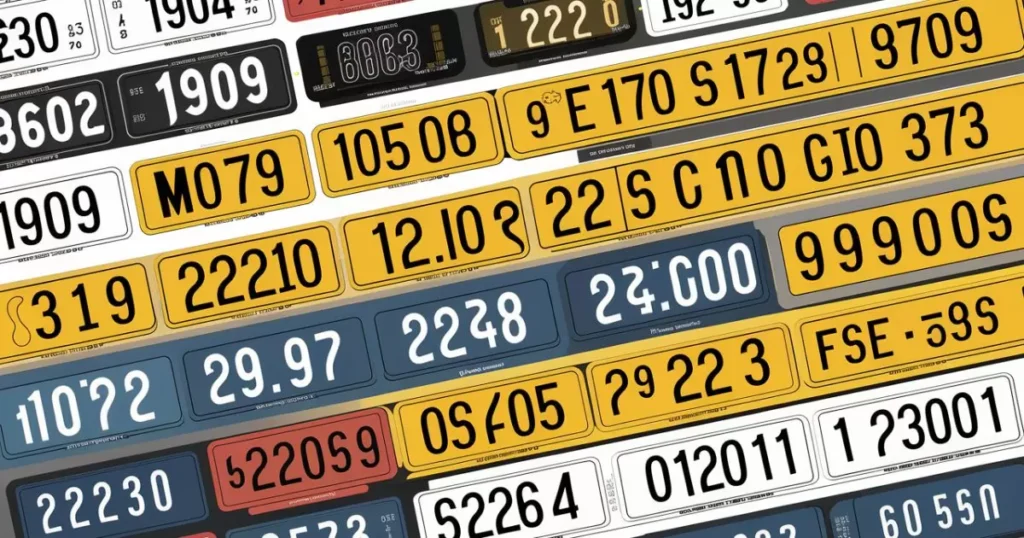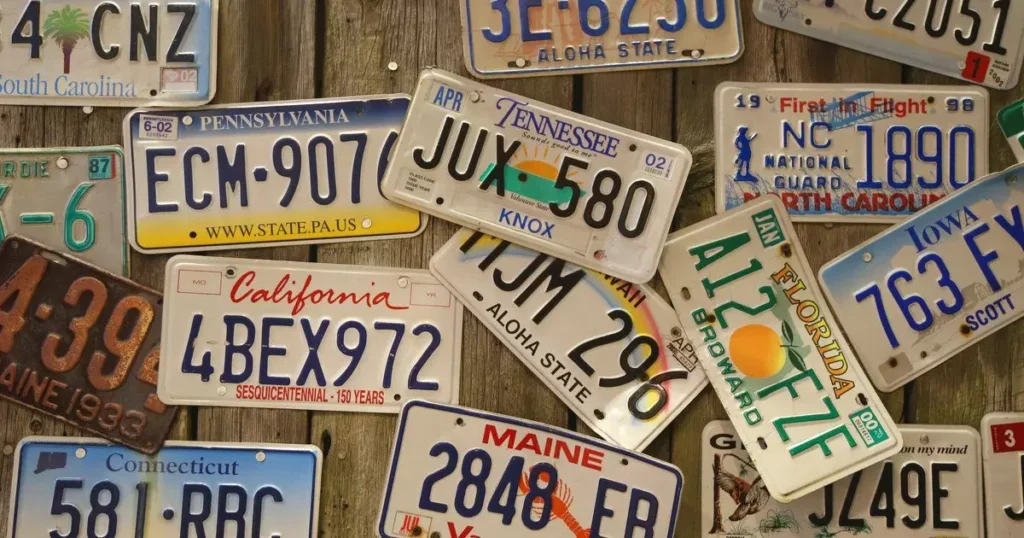Introduction
“Number plates use distinct colours to enhance visibility and safety, with white and yellow ensuring clear identification day and night.”
In the realm of vehicle identification, the colours of number plates play a crucial role in ensuring visibility and legibility. In the UK, the use of white and yellow plates has become standard practice, but this choice is not arbitrary.
It stems from a combination of historical evolution, legal requirements, and practical considerations aimed at enhancing road safety. The distinct colours serve not only to meet regulatory standards but also to provide maximum contrast against various backgrounds and under different lighting conditions.
This system facilitates efficient law enforcement, reduces identification errors, and helps in managing vehicle-related activities effectively. As we explore the reasons behind these colour choices, we uncover a blend of historical context and technological advancements that highlight the ongoing commitment to improving vehicle visibility and safety on the roads.
The Evolution of UK Number Plate Colours

The colour of number plates in the UK has evolved significantly since their introduction in 1904. The first formalisation of number plate colours occurred in the 1960s when the UK government introduced a new colour scheme to standardise vehicle identification.
The 2001 introduction of the new design saw the standardisation of the white and yellow colour scheme, which has remained in place with minor modifications. This change was part of a broader initiative to make plates more reflective and legible under various lighting conditions.
The evolution of number plate colours reflects a continuous effort to enhance road safety and vehicle identification efficiency.
The Legal Requirements for Number Plate Colours
According to the Road Vehicles (Display of Registration Marks) Regulations 2001, number plates must have a white background with black characters at the front of the vehicle and a yellow background with black characters at the rear.
This regulation ensures that number plates are easily visible and readable in all lighting conditions, which is crucial for both everyday driving and law enforcement activities.
The legal framework also specifies the size and spacing of the characters on the plates, as well as the materials used. For example, number plates must be reflective to improve visibility at night.
Historical Context: Why Different Colours Were Introduced
Prior to the 1960s, vehicles used a variety of methods to display their registration numbers, which led to inconsistencies and difficulties in identifying vehicles, especially at night or in poor weather conditions.
The decision to use white and yellow plates was based on research indicating that these colours provided the best contrast and visibility against a range of backgrounds.
The 1960s standardisation aimed to create a uniform system that would be easily recognizable and help in reducing the frequency of road accidents and improving traffic enforcement.
Current Standards for Number Plate Colours in the UK
The current standards for number plate colours in the UK, as specified by the Road Vehicles (Display of Registration Marks) Regulations, require white plates with black characters at the front and yellow plates with black characters at the rear.
The black text provides a clear and sharp contrast against the white and yellow backgrounds, which are reflective to enhance visibility at night.
In addition to the colour requirements, there are specific regulations regarding the size and font of the characters on number plates. The font must be a standard style that is easily readable, and the spacing between characters is strictly regulated.
The Role of White and Yellow in Number Plate Visibility
White plates at the front of vehicles provide a bright, reflective surface that stands out against most backgrounds, making it easier for drivers and law enforcement to read the number plates during the day.
The yellow plates at the rear offer high contrast with the typically darker surroundings and are particularly effective at night when illuminated by headlights.
The combination of these colours ensures that number plates are visible in a range of environmental conditions, from bright sunlight to low-light and nighttime scenarios. The reflectivity of the plates also plays a crucial role in improving visibility and safety, as it enhances the readability of the characters regardless of external lighting conditions.
Practical Benefits of Colour-Coded Number Plates
Colour-coded number plates offer several practical benefits beyond mere visibility. The use of distinct colours for front and rear plates helps reduce confusion and errors in vehicle identification.
Additionally, the standardisation of colours helps streamline vehicle registration and enforcement processes. It makes it easier for authorities to recognize and verify number plates, which can aid in reducing vehicle-related crimes and ensuring compliance with road regulations.
The consistent use of colours across the entire fleet of vehicles also helps in maintaining a clear and orderly system for vehicle identification.
How Colour Choices Affect Number Plate Legibility
The choice of colours for number plates has a significant impact on their legibility. White and yellow were selected because they provide optimal contrast with the black characters, making the numbers and letters stand out clearly.
This contrast is crucial for ensuring that number plates can be read quickly and accurately, whether by human observers or automated systems like cameras used for traffic enforcement.
The reflectivity of the plates also enhances legibility, particularly at night or in low-light conditions. Reflective materials used in the production of number plates bounce light back towards the source, making the characters more visible and easier to read. This feature is especially important for night-time visibility and contributes to overall road safety.
The Impact of Number Plate Colours on Road Safety
Number plate colours play a crucial role in road safety by improving vehicle identification and visibility. The high contrast between the black characters and the white or yellow backgrounds helps drivers quickly and accurately read number plates, reducing the risk of accidents caused by misidentification or lack of clarity.
Moreover, the standardised colour scheme aids law enforcement in monitoring and controlling traffic. It allows for efficient identification of vehicles involved in traffic violations or criminal activities, enhancing overall road safety. The reflective properties of the plates also contribute to safer driving conditions by ensuring that number plates are visible in various lighting conditions.
SurePlates Ultimate Guide To 4D Number Plates [Infographic]
International Comparison: Number Plate Colours Around the World

Number plate colours vary widely around the world, reflecting different national regulations and aesthetic preferences. In many countries, the standard colour scheme for number plates is similar to the UK’s, with white and yellow plates providing high visibility. However, there are notable differences in other regions.
For example, in the United States, number plates often feature a range of colours and designs depending on the state, with some states using combinations of blue, green, or red.
In Europe, many countries follow a similar colour scheme to the UK, with white plates for the front and yellow or reflective plates for the rear. This uniformity helps in cross-border traffic management and vehicle identification within the EU.
However, variations do exist, with some countries opting for different shades or additional design elements to meet local needs and regulations.
Future Trends in Number Plate Colour Regulations
Future trends in number plate colour regulations are likely to focus on enhancing visibility and incorporating new technologies. Advances in materials and reflective coatings may lead to even more effective number plates that improve readability under a wider range of conditions.
Additionally, the integration of electronic or digital number plates could become more common, offering dynamic features such as changing colours or displaying additional information.
Regulations may also adapt to address emerging challenges, such as the increasing use of automated vehicle recognition systems and the need for better integration with these technologies. As vehicle design and road safety requirements evolve, number plate colour standards will likely continue to adapt to meet new demands and enhance overall effectiveness.
Answers to key Questions
1. Why are number plates different colors?
Number plates come in different colors to signify various types of vehicles, their registration statuses, and their uses. For example, in many countries, the color of a number plate can indicate whether a vehicle is private, commercial, or government-owned. Different colors help distinguish between regular vehicles, taxis, diplomatic vehicles, and others for easier identification and enforcement of regulations.
2. What does a yellow number plate usually indicate?
In many places, a yellow number plate is used for commercial vehicles, such as taxis or delivery vans. The bright color helps to easily identify these vehicles and distinguish them from private cars, which typically have white or light-colored plates. This color coding helps in regulatory enforcement and public safety.
3. Why do some countries use red number plates?
Red number plates are often used to indicate temporary or provisional registrations. These plates are typically issued for new vehicles before they receive their permanent plates or for vehicles that are being transferred between owners. The bright red color helps authorities quickly identify vehicles with temporary registrations.
4. What is the significance of blue number plates?
Blue number plates are frequently used for vehicles owned by government officials or diplomats. The color helps differentiate these vehicles from others and can signify special privileges or diplomatic immunity. In some cases, blue plates may also indicate vehicles used for specific purposes, such as police or emergency services.
5. Are there any special colors for vintage or classic cars?
Yes, some countries have special color schemes for vintage or classic cars. These colors often include unique combinations or designs to help identify these vehicles as registered classics. The specific colors and designs can vary by country, but they generally aim to highlight the vehicle’s status as a historical or collectible item.
Conclusion
In conclusion, the different colours used for number plates serve a crucial role in enhancing visibility and road safety. The UK’s standardisation of white for front plates and yellow for rear plates ensures high contrast and reflectivity, making number plates easily readable in various lighting conditions.
This colour scheme not only facilitates efficient vehicle identification but also supports effective law enforcement and traffic management. Internationally, while number plate colours vary, the focus remains on improving legibility and safety.
As technology evolves, future trends may see further innovations in number plate design, potentially incorporating digital technologies or enhanced reflective materials. The thoughtful application of colour in number plates demonstrates a commitment to road safety and efficient vehicle management, underscoring the importance of clear and consistent vehicle identification across different conditions.

Hi! I’m Sophia Bennet, the author of drivecarspedia.com. I share my passion for cars through helpful tips, reviews, and easy-to-understand information. Join me as we explore the exciting world of automobiles together!








